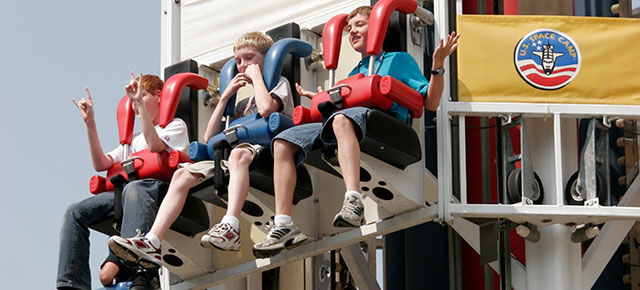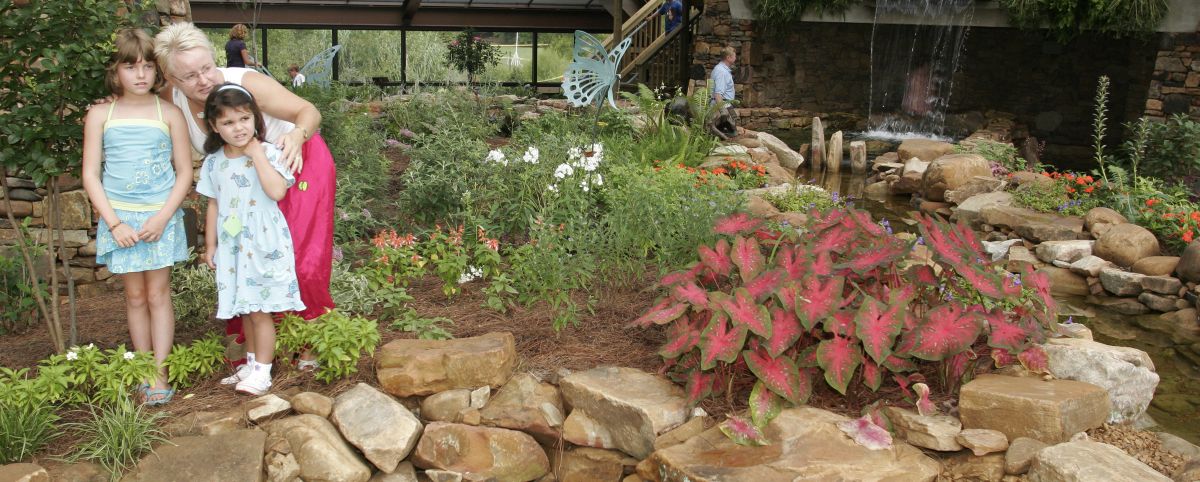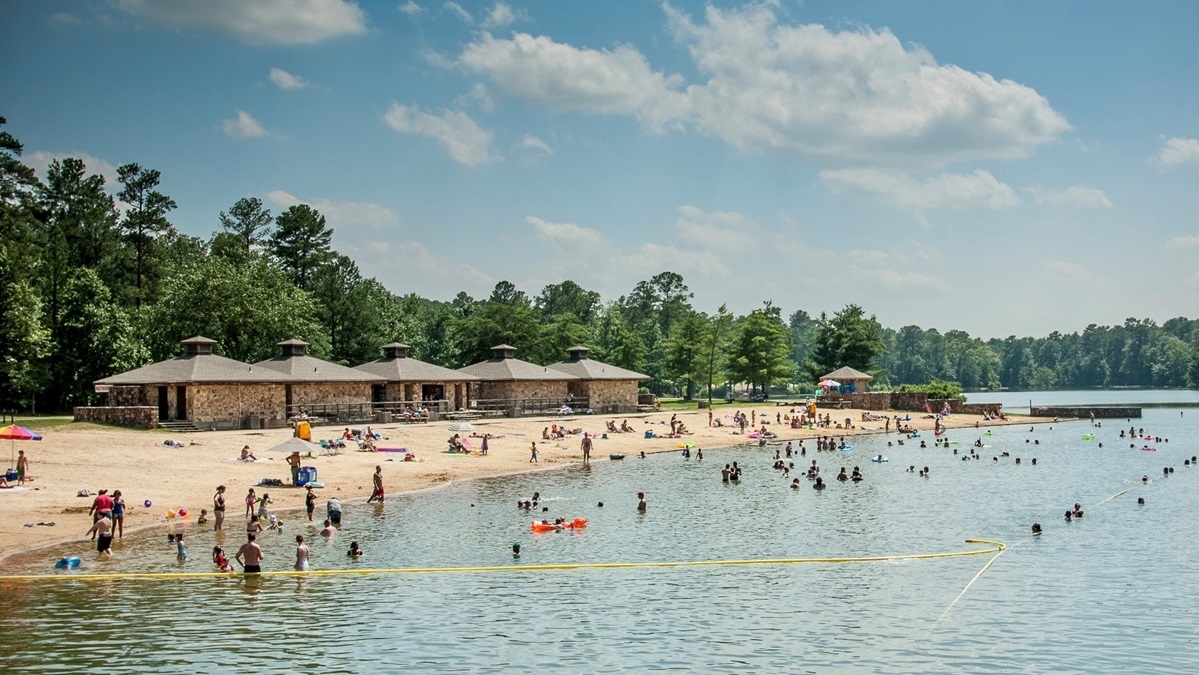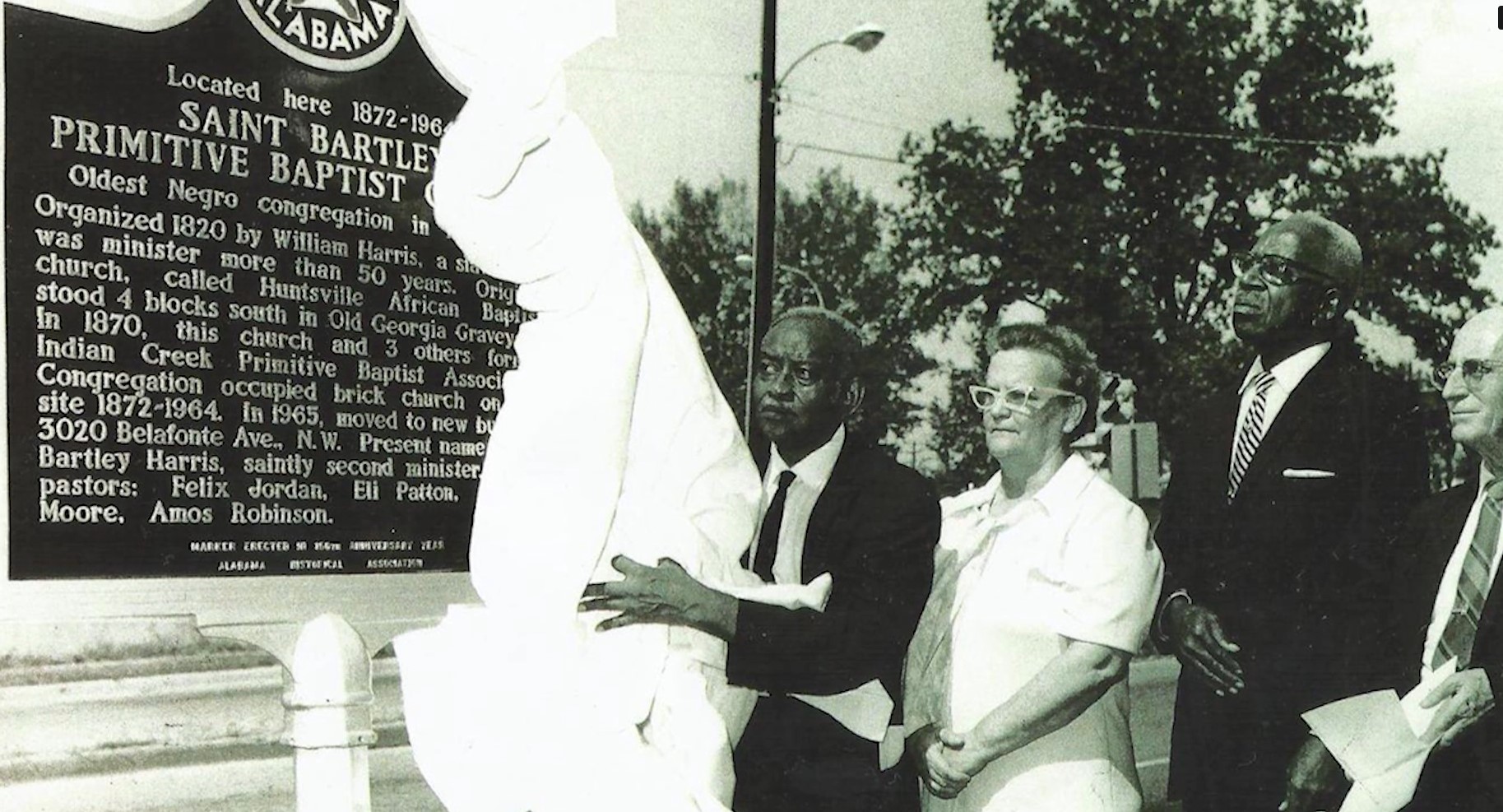Alabama Road Trips: Huntsville – To the Moon and Back by Dinner

 The U.S. Space and Rocket Center in Huntsville is the largest and most comprehensive space flight museum in the world. Located just off I-565, the center is easy to spot from miles away by the 38-story replica of the Saturn V rocket standing in front of it. The space center’s side parking lot is located alongside the futuristic dormitories used for Space Camp and an 89-ton mock-up of the Pathfinder space shuttle.
The U.S. Space and Rocket Center in Huntsville is the largest and most comprehensive space flight museum in the world. Located just off I-565, the center is easy to spot from miles away by the 38-story replica of the Saturn V rocket standing in front of it. The space center’s side parking lot is located alongside the futuristic dormitories used for Space Camp and an 89-ton mock-up of the Pathfinder space shuttle.
Walking up the sidewalk to the center, you will see both the grave of Miss Baker, a spider monkey launched into space and successfully recovered, and an SR-71 Blackbird spy plane on display. The SR-71 Blackbird planes were used by the U.S. Air Force from 1964 to 1998 as a strategic reconnaissance aircraft. They cruised at Mach 3 (three times the speed of sound) and set a jet speed record by traveling from New York to London in one hour and 54 minutes.
Once inside the space center, you can purchase a ticket and visit a gift shop full of NASA and science souvenirs, including flights suits, space craft models, and Apollo and shuttle program collectibles. There is also a six-story Spacedome IMAX Theater featuring a large domed screen for full-length movies and space-related IMAX presentations. Tickets for movies are additional or may be purchased as part of a combination admission ticket.
Explore exhibits and collections
The U.S. Space & Rocket Center, created by the state of Alabama in 1970, has an extensive collection of original space exploration hardware, including Mercury and Gemini capsule trainers, the Apollo 16 capsule and one of the few V-2 rockets in the nation. You can also see the actual desk where Dr. Wernher von Braun worked as director of the Marshall Space Flight Center and his 1969 calendar where written by his hand in pencil on July 20 are the words: “lunar surface achieved.”
It is awe-inspiring to think of the progression that led man from the Quick plane to the Saturn V moon rocket in less than 70 years.

Don’t Miss
Space Shot and Other Space Travel Simulators
Be sure to experience Space Shot, where you can rocket 140 feet straight up in 2.5 seconds with 4 G’s of force and experience 2-3 seconds of weightlessness followed by a 1 G free fall, and other space travel simulations while at the Space and Rocket Center.
Others include:
G-Force Accelerator, where you can spin at approximately 24 revolutions per minute and experience three times the force of gravity – what astronauts felt during a shuttle launch.
Apollo Cockpit Trainer, a simulator that shows what it would be like to be inside the command module on an Apollo mission to the moon. Simulators such as this one are crucial in astronaut training. Without the simulator training, the crew that safely returned to Earth during a 1970 explosion aboard the Apollo 13 Service Module may not have survived.
Mars Mission, Mars Climbing Wall, where you can learn about the red planet and scale part of the tallest volcano in the solar system.
In addition to simulators and other attractions, the center offers hands-on exhibits:
Discovery Theater Shows are offered three times daily and allow visitors to see how science has continually propelled NASA’s space exploration. The shows include audience interaction and live demonstrations.
Kids Cosmos Energy Depletion Zone offers children under the age of 8 (accompanied by an adult) the opportunity to enjoy interactive fun in the Space Station.
Rocket Park, located behind the rocket center, is home to an amazing collection of U.S. Army missiles and NASA rockets, plus the accurately depicted re-creation of Tranquility Base, where Apollo 11 landed on the moon.
Discover wonders of the Davidson Center
A short walk through Rocket Park will lead you to the Davidson Center for Space Exploration, which was specially designed to house the original engineering model, the first Saturn V rocket. It was never launched into space. The rocket is suspended 10 feet above the floor, allowing visitors to walk underneath it. The Saturn V is a National Register of Historic Landmark and was named one of the Seven Wonders of America by “Good Morning America.”
There is a great photo opportunity when you enter the Davidson Center and climb the stairs to the main exhibit hall. The Quick monoplane that was invented by William Lafayette Quick and flown in 1908 in Hazel Green, Ala. is suspended from the ceiling. A photo taken of the Quick plane from the top of the staircase will also show the 38-story replica of the Saturn V rocket visible outside the window. It is awe-inspiring to think of the progression that led man from the Quick plane to the Saturn V moon rocket in less than 70 years.
Once in the main area of the Davidson Center, you will be overwhelmed by the awesome size of the Saturn V rocket as you walk directly underneath this engineering marvel. The Saturn V on display is one of only three remaining in the world. The rest of the 68,000 square-foot Davidson Center is filled with artifacts from the Apollo era, including an actual moon rock from the Apollo 12 mission, a lunar excursion module, lunar rover vehicle, a mobile quarantine facility, the Apollo 16 capsule and actual spacesuits worn by the astronauts. You can walk across the same metal access arm walkway that the astronauts used to enter their space capsules.
A special program offered at the rocket center is Space Camp. The idea for Space Camp came from Dr. von Braun in 1977 when he was touring the rocket center and noticed a group of children studying the exhibits and taking notes. Dr. von Braun said, “We have band camp, football, cheerleading; why don’t we have a science camp?” Space Camp was founded in 1982 to provide residential and day camp educational programs for children and adults. Space Camp and Space Academy programs include the original simulated astronaut training camps conceived by Dr. von Braun and its sister program, Aviation Challenge, which offers simulated jet pilot training.
Space Camp was recently featured in the Hallmark Hall of Fame movie A Smile as Big as the Moon on ABC television. The movie is based on a true story about a special education teacher’s dream of helping his students attend Space Camp.

Butterfly House at Huntsville’s Botanical Gardens
Other Space Fun in Huntsville
Kids will love Sci-Quest, located across I-565 from the U.S. Space & Rocket Center. Sci-Quest is a hands-on science center with more than 100 permanent, interactive exhibits in seven different subject areas. Unlike a typical museum, Sci-Quest’s exhibits are designed to engage, educate and entertain in a fascinating way. For example, the PlayMotion exhibit, lets people interact with projectors to play games meant to stimulate the imagination. From catching falling planets to building trees and playing beach volleyball, the possibilities are seemingly endless and all educational. There’s even a section dedicated to younger children learning about science through age-appropriate activities such as a giant keyboard pad that introduces them to musical tones. Other exhibit areas include Grossology (elements of the human body), Earth sciences and electricity.
Drive to the top of Huntsville’s Monte Sano to see the Von Braun Astronomical Society’s Planetarium and Observatory, located inside Monte Sano State Park, just past the park office. Dr. Wernher von Braun and his colleagues used the observatory’s telescope to search for possible landing sites for the Apollo program. The planetarium offers programs to the public every Saturday night starting at 7:30.
Where To Stay
Whether you’re looking for a hotel, an RV camping spot or a cozy and quiet bed and breakfast, Huntsville offers nearly 6,200 rooms to choose from. You can share a view of the Saturn V rocket or be close to the hottest shopping and dining spots. For a list of lodging and dining options in the area, visit Huntsville.








